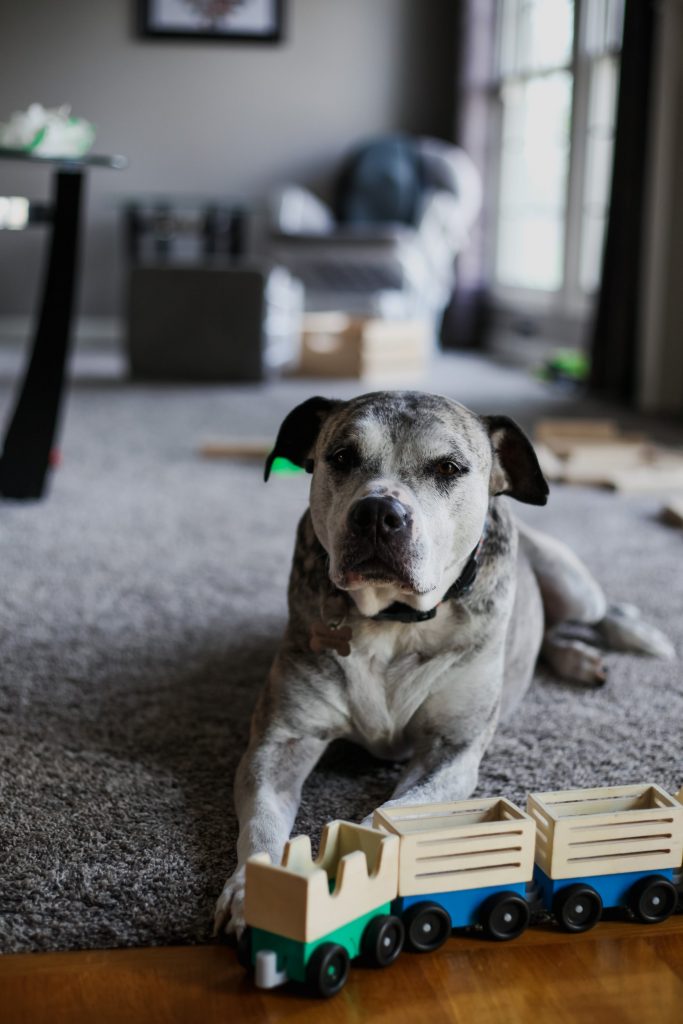Have you ever noticed your dog’s hair turning gray and wonder if stress could be the culprit? Recent studies reveal that, just like in humans, stress can indeed cause premature graying in dogs. Can dogs go gray from stress?
This blog post will help you understand more about this phenomenon, helping identify the signs of stress-induced aging in your furry friend. Keep reading to learn what’s causing Fido’s white hairs and how best to manage it!

Key Takeaways
- Stress can cause premature graying in dogs, just like in humans.
- Dogs show signs of stress through behaviors such as acting out, avoiding people or pets, and changes in sleep or eating habits.
- Common causes of stress in dogs include changes in routine, loud noises, being left alone for long periods, and medical issues.
- Studies have found that gray hair in dogs is caused by cellular stress with a genetic component.
- Genetics, medical issues, and behavioral problems can also contribute to premature graying in dogs.
- To manage stress in dogs, it’s important to identify triggers, create a calm environment, and seek professional help if needed.
Understanding Stress in Dogs
Dogs can exhibit signs of stress through various behaviors and physical symptoms, which can be caused by a range of factors.
Signs of stress in dogs
Dogs show stress in many ways. They may act out or seem sad. Some dogs do not eat well if they are stressed. Other signs can be a change in how much they sleep, bark, shake, or drool.
Dogs might also hide or avoid people and other pets when feeling stressed. A dog that pees inside could be upset too. It’s important to notice these signs as early as possible for the health of your pet.
Causes of stress
Dogs can experience stress from various factors. Some common causes of stress in dogs include changes in routine, loud noises like thunderstorms or fireworks, being left alone for long periods of time, and unfamiliar environments.
Other stressors may include social isolation, separation anxiety, the introduction of a new pet or family member, or even medical issues. It’s important to remember that every dog is different and what might cause stress in one dog may not affect another.
Understanding the potential sources of stress can help owners identify triggers and manage their dogs’ well-being effectively.

Can Stress Cause Premature Graying in Dogs?
Studies have shown that stress can indeed cause premature graying in dogs, with cellular stress playing a significant role in this phenomenon.
Study findings
A recent study discovered that dogs can actually go gray due to stress, just like humans. The researchers found that dogs who are anxious or impulsive tend to have gray hair on their muzzle at a young age.
This premature graying could be a sign of anxiety and impulsivity in dogs. It turns out that the gray hair is caused by cellular stress, which has a genetic component. The study’s results were described as “striking” by the researchers, supporting the long-suspected idea that stress can visibly affect our furry friends in similar ways it affects us humans.
So if you notice your dog’s hair turning white at an early age, it might be worth looking into ways to manage their stress levels.
The role of cellular stress in greying
Gray hair in dogs is not just a sign of old age, but it can also be caused by stress. A new study found that cellular stress plays a role in the premature graying of dogs’ fur. This means that when dogs experience high levels of psychological stress or anxiety, it can affect their hair color.
The study suggests that the gray hairs are caused by cellular stress, which has a genetic component. So if your dog is showing signs of premature graying, it could be an indication that they are feeling stressed or anxious.

Other Factors that Contribute to Premature Graying
Medical issues, genetic and behavioral issues can also contribute to premature graying in dogs.
Genetics
Genetics can also play a role in premature graying in dogs. Some breeds are more prone to early graying than others, due to their genetic makeup. While stress-induced gray hair is a result of cellular stress, the genetics of the dog can contribute to how quickly this occurs.
So, if your dog has parents or relatives that went gray at an early age, they may be more likely to experience premature graying themselves. It’s important to remember that while genetics plays a part, it’s not the sole factor behind premature graying in dogs.
Other factors like medical and behavioral issues, as well as high levels of stress and anxiety, can also contribute to this phenomenon.
Medical issues
Medical issues can also contribute to premature graying in dogs. Certain health conditions, such as autoimmune disorders or thyroid problems, can affect the pigmentation of a dog’s hair and cause it to turn gray.
Additionally, medical treatments like chemotherapy or radiation therapy may also lead to hair color changes in dogs. It’s important to consult with a veterinarian if your dog is experiencing premature graying to rule out any underlying medical issues that may be causing it.
Behavioral issues
Dogs with behavioral issues, such as anxiety or impulsivity, are more likely to experience premature graying. This gray hair may appear on their muzzle or other parts of their body at a young age.
The stress and strain from these behavioral problems can cause cellular stress, leading to the development of gray hairs. It’s important for dog owners to address these behavioral issues and provide their dogs with a calm and supportive environment.
How to Manage Stress in Dogs
Identify triggers, create a calm environment, and seek professional help to effectively manage stress in dogs.
Identifying triggers
Stress can affect dogs differently, so it’s important to know what triggers their anxiety. Some common triggers include loud noises like thunderstorms or fireworks, being around unfamiliar people or animals, changes in routine or environment, and being separated from their owners.
It’s essential to pay attention to your dog’s behavior and body language when they are stressed. Look for signs such as panting, pacing, trembling, excessive barking or whining, hiding or cowering, loss of appetite, restlessness, and seeking constant reassurance.
By identifying these triggers early on, you can help alleviate your dog’s stress and create a calmer environment for them.
Creating a calm environment
To help manage stress in dogs and potentially prevent premature graying, it’s important to create a calm environment for your furry friend. Make sure their living space is peaceful and free from any triggers that might cause anxiety or stress.
Provide them with a comfortable bed or den where they can retreat when they feel overwhelmed. Establish a consistent daily routine that includes regular exercise, playtime, and relaxation.
Additionally, consider using calming aids such as pheromone diffusers or music specifically designed to soothe anxious dogs.
Seeking professional help
If you notice signs of stress in your dog, it’s important to seek professional help. Veterinarians and animal behaviorists can provide valuable guidance on how to manage your dog’s anxiety and reduce their stress levels.
They can help identify triggers that may be causing the stress and develop a customized plan to create a calm environment for your dog. With their expertise, you can ensure your furry friend receives the support they need to live a happier, stress-free life.

Conclusion
In conclusion, the study findings suggest that stress can indeed cause premature graying in dogs. Dogs that are anxious or impulsive may be more prone to gray hair at a young age. It’s important for dog owners to manage their pet’s stress levels and seek professional help if needed to ensure their furry friends stay happy and healthy.
FAQs
1. Can stress cause dogs to go gray?
Yes, stress-induced graying in dogs is real. Mental tension, worry, and anxiety can lead hair turning white on a dog’s face.
2. What are the causes of gray hair in dogs?
Gray hair in senior dogs is often due to aging, but it can also be caused by genetic factors or cellular stress causing grey hairs.
3. Can young dogs have gray hair too?
Yes! Even at a young age, some impulsive and anxious dogs may show signs of premature greying on their faces because of tension or emotional distress.
4. Are there specific breeds prone to early graying?
Certain dog breeds do tend to go grey earlier than others because of genetic factors which lead them towards early onset gray hair.
5. Is all white fur on my dog a sign of stress?
Not always! A patch of white hair could be due to many factors including genetics or aging, not just nervousness or pressure alone.
6. Does going gray mean my dog will lose its fur as well?
Although it can occur together, white hair from psychological strain doesn’t directly lead to hair loss in dogs; they are separate conditions with different causes.


